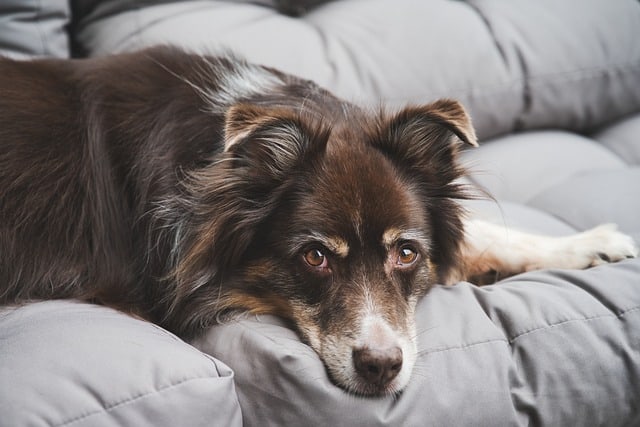Suppose you consider bringing a Red Merle Australian Shepherd home. They are excellent for several activities, like herding, obedience training, and agility courses, and make loyal, friendly, and lovable pets.
Before committing to bringing one home, it’s important to do your homework and understand the unique characteristics and traits of the animals.
In this detailed guide, we will go through the background of the Red Merle Aussie, their physical attributes, personality traits, health issues, and much more. We hope the information given will allow you to choose if a Red Merle Australian Shepherd is the best choice.
Australian Shepherd’s Color, Shape, and Size
Red Merle Australian Shepherds are a medium to large breed. The Red Merle Aussie male will typically wind up being about 50-65 pounds, and females weigh in around 40-55 pounds (or so. I have one chunky monkey and one that is skinny no matter how much he eats — so they are like people in that respect I suppose).
Males usually stand 20-23 inches tall, while your female might only be 18-21 inches tall. But again, my chunky one is the shorter of the two, and he’s a male…
While there is not a significant size difference between males and females of the breed, males tend to be slightly larger and more robust in overall appearance.
Both males and females have solid and athletic builds, muscular bodies, and deep chests.
These fuzzy balls of energy have a thick, double coat that comes in a variety of fun colors– red merle, black, red, and blue merle — all are guaranteed to stick to your clothes and couch and will have friends raving about the food you cooked them with fur in it.
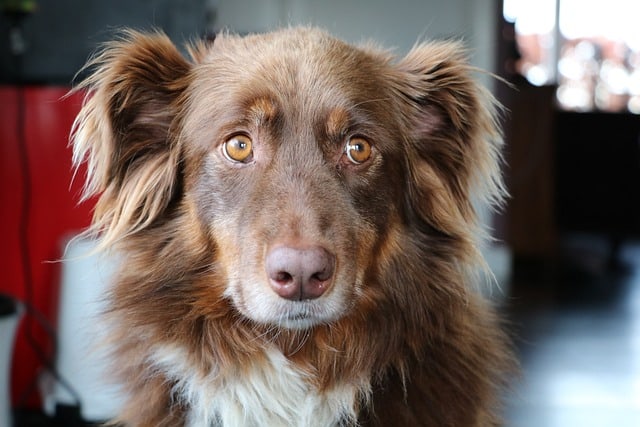
History of the Red Merle Australian Shepherd
As a sub-type of the original American-created Australian Shepherd breed, “Red Merle” Aussies are a visually distinctive and eye-catching color combination. The breed is said to have evolved from a cross between the Border Collie, Australian Kelpie, and Australian Cattle Dog, among other herding dogs. Western U.S. farmers and ranchers were the first to employ this breed for cattle herding.
Red Merle Australian Shepherds are a versatile breed that has gained popularity for various uses over time. The breed’s reputation for smarts, vitality, and adaptability has made it a favorite among families looking to add a dog to their fold. The coat of the Red Merle variety of the breed has a striking red and white merle pattern.
Red Merle Aussies have become increasingly popular as companion animals, working dogs, and even show dogs in recent years. This breed is highly sought after by those in need of a companion who is protective, loyal, bright, playful, and full of life; the American Kennel Club officially recognizes them.
Physical Characteristics of these Shepherds
Physical Characteristics
These animals are medium-to-large dogs with robust, athletic frames. Typically, males weigh 50–65 pounds and are 18–23 inches tall at the shoulder, while women are more petite at 40–55 pounds and 17–21 inches tall. The breed’s long, strong neck and deep chest are hallmarks of its well-proportioned and balanced physique.
The Coloration of Their Coats and Fur Type
A dense double coat of medium to long length characterizes the Red Merle Australian Shepherd. The coat color is a red merle pattern, which can appear on the dog’s straight or slightly wavy coats, which is the breed’s most defining physical characteristic. The breed is protected from the elements by its thick, weatherproof coats.
A recessive gene causes the appearance of a red coat color. Hence they are far rarer than their blue merles or black counterparts. To a similar extent, the puppy’s pattern is caused by a recessive gene, whereas a dominant gene causes a solid color coat. Because red colors and merle patterning are recessive, the birth of these puppies is statistically less likely to occur from the parents.
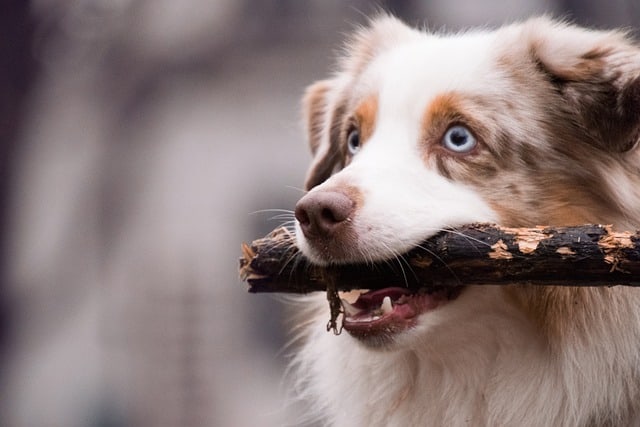
Appearance and Body Type
Its ears and tail
Some breed standards allow for a naturally occurring tail length in Red Merle Australian Shepherds. However, docking is the norm. Long, triangular ears characterize these dogs carried low over the cheeks. Ears have a thin coating of hair covering them, and they respond well to both touch and sound.
Nose and Head-shape
The balanced head on Red Merle Australian Shepherds includes a large skull and a powerful, square muzzle. The breed’s characteristic almond-shaped, expressive eyes come in various colors, including brown, blue, and amber. A pair of medium-sized nostrils and a sturdy jaw with a complete set of teeth that connect in a scissors bite are further hallmarks of this breed.
Toes, Legs, and Knees
Red Merle Australian Shepherd’s legs are long and lean, with remarkable muscular definition. The breed’s big, spherical feet are protected by thick pads that help them navigate uneven ground. The animal’s rear legs are powerful and well-muscled, and its long, arched toes are put to use in herding and other tasks.
Movement and Gait
In addition to being a highly active breed, Red Merle Australian Shepherds are also renowned for their graceful and fluid gait. Typical of the breed is a lengthy, low-impact stride that covers a lot of ground with each step. The breed is ideal for herding, obedience training, and agility competitions due to its rapid, abrupt movements.
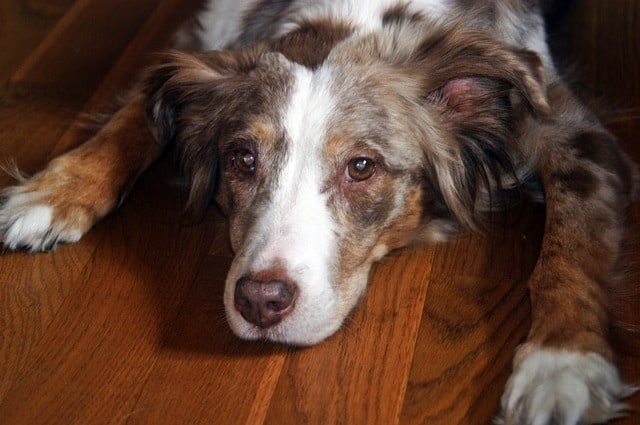
Personality Traits of the Red Aussie
Work Ethics, Intelligence, and Trainability
The shepherds are a highly intelligent, smart breed. They have a super strong work ethic. These dogs are really easily trained and very energetic. They excel at obedience and agility training. They also are capable of learning a wide range of tasks and commands. These dogs often get used as working dogs. They can do a whole bunch of jobs like herding, search, and rescue, and as therapy animals. Mine absolutely love the outdoors.
Loyalty and affection
These Red Merle Aussies are loyal beyond most pets. They are affectionate, protective, and known for their strong friendship with their masters. The Aussie is “generally” friendly to children and other pets and is a devoted and devoted companion. They are also noted for their protectiveness. Strangers may be wary of them until properly introduced.
Energy and Exercise Requirements
These dogs are an active breed that demands tons of mental and physical stimulation. They require frequent activity and are well-suited to hiking, running, and retrieving (and are prone to driving their owners crazy if they get bored). To prevent boredom and destructive behavior, owners must give their dogs appropriate workouts and mental stimulation.
Playfulness and socialization
Despite their strong work ethic, Red Merle Australian Shepherds are a playful, intelligent breed that enjoys interacting with its family and participating in games such as fetch and tug of war. The breed is also gregarious and enjoys associating with other dogs and people. Owners must socialize their Red Merle Australian Shepherd from a young age to help them grow into well-rounded and confident canines.
Common Health Concerns
Red merle Aussies, like all breeds, can have health issues. Hip dysplasia, vision difficulties, and skin allergies are all frequent health concerns among Australian Shepherds, including the Red Merle Australian Shepherd. Owners must be aware of these health issues and engage with their veterinarian to monitor and manage them.
The Importance of Regular Veterinary Exams
Aussies must visit the veterinarian regularly to ensure their health. Regular check-ups can help detect any health problems early on, making them easier to treat. During these examinations, the veterinarian will examine the dog’s ears, eyes, teeth, and other body systems to ensure they are in good functioning.
The Function of Genetics
Genetics play a role in your Red Merle Aussies health, and owners should be aware of any inherited health concerns that may run in their dog’s family line. To determine what health issues may be prevalent in the breed, owners can ask the breeder about the health history of the dog’s parents and grandparents. Owners can take actions to prevent or control potential health issues by understanding them.
Training and Exercise
Australian Shepherd intelligence and trainability
Aussies are highly clever and easy to train, making them suitable for various activities. The breed excels at obedience and agility training and can learn multiple exercises and commands.
The Value of Mental Stimulation
Australians are active people who require a lot of mental and physical stimulation to keep happy and healthy. Owners must provide their dogs with numerous opportunities to learn new things and push their minds. Training sessions, puzzle toys, and other interactive activities can help with this.
Exercise Is Required
Australians are active people who require frequent exercise to keep fit and happy. The breed is well-suited to sports like hiking, running, and fetch, and it benefits from a large yard or access to a park or open space. Owners must offer appropriate exercise for their dogs to minimize boredom and destructive behavior.
Potty Training
Are you trying to potty train an Australian Shepherd? I wrote an easy-to-follow, extensive potty training article that you can read here… it’s the most visited page on this whole website!

Training Suggestions
These dogs are highly trainable. The experience of training an Aussie can be enjoyable for both the owner and the dog (it can also make you crazy if you fail, which is why I HIGHLY suggest getting THIS… it’s for ALL breeds, but it’s seriously some of the best advice I’ve ever read under $1000 (this isn’t even 50 bucks). Positive reinforcement strategies, like treats and praise, should inspire the dog and encourage good behavior. When training Aussies, consistency is also important because they respond well to routine and structure. Mine respond to training best when I do it outdoors.
Socialization
Socialization is crucial to Aussie training since it helps the dog become well-rounded and confident. To help their dog feel comfortable and well-adjusted, owners should expose them to various people, places, and situations from a young age.
Training Sessions
Training lessons can assist owners in learning how to train their Aussies and socialize them with other people and canines. Local pet stores, dog training centers, and local groups and clubs are common places to find training programs.
Investing in a Professional Trainer
If owners have problems teaching their Aussies or wish to advance their dog’s training, they should consider hiring a professional trainer. Professional trainers have the experience and expertise to assist owners in teaching their dogs and can provide personalized training programs to match their dog’s individual needs. If the cost of a personal trainer is an issue, THIS is worth trying.
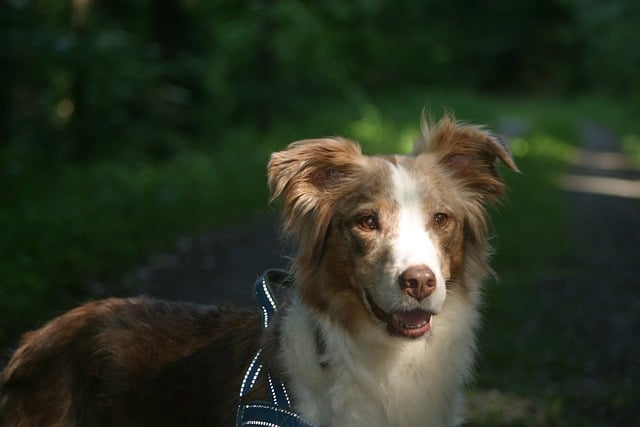
Nutrition Needs
Aussies require a well-balanced diet to suit their nutritional requirement. Because they are so energetic, they need a high-protein diet to maintain muscle development and energy requirements. Aussies also require a diet rich in good fats, like omega-3 fatty acids, to maintain healthy skin and coats.
Size and frequency of portions
The dog’s age, size, and activity level will determine the actual portion size and feeding frequency. To determine the proper serving size for your Aussie, consult a veterinarian or a pet nutritionist. Adult Aussies should be fed twice a day, with puppies and young dogs requiring more frequent feedings.
Food of Good Quality
The quality of the food you feed your Australian Shepherd is critical to their general health and well-being. The breed is recommended to be fed high-quality commercial dog food designed specifically for their life stage and demands. Examining the ingredient list and selecting foods manufactured with high-quality proteins and healthy fat sources is critical. Foods with fillers, artificial additives, and low-quality components should be avoided.
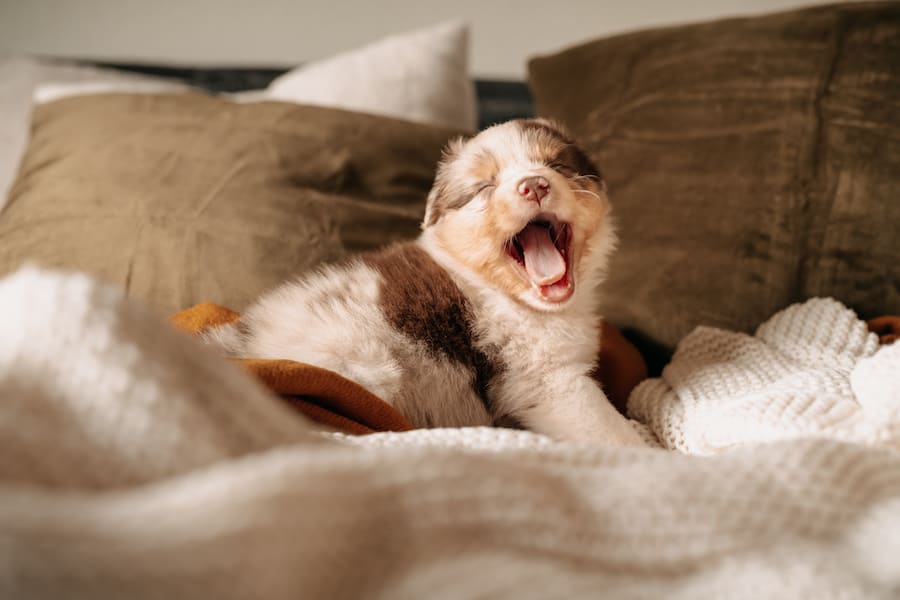
Grooming Your Red Merle Aussie
The Coat Colors
Your part copper, part red colored ball of fur will have a thick, double coat that needs to be groomed regularly to keep its health and attractiveness. Brush the breed at least once a week to remove tangles and matting. Brushing promotes healthy skin and a lustrous coat by distributing natural oils throughout the copper coat.
Bathing
Red Merle Australian Shepherds, in addition to regular brushing, must be bathed every few months to keep their coats clean and healthy. Using a high-quality dog shampoo specifically developed for their coat type and skin needs is critical. Human shampoo should be avoided since it might strip the coat of its natural oils and irritate the skin.
Ear Treatment
Ears of the breed should also be checked for symptoms of infection regularly and cleaned as needed. It is critical to keep the ears clean and dry to avoid ear infections, which can be unpleasant and expensive to treat. If you observe any redness, swelling, or discharge in your dog’s ears, you should see a veterinarian very away.
“I absolutely love grooming my Red Merle Australian Shepherd. It’s such a bonding experience and I love seeing how happy and proud my dog is after a good grooming session. Plus, their eye color pops out more because the appearance of their coat is so beautiful and soft when it’s well-maintained. Be prepared for a mouth full of fur though”

The Cost of a Puppy
Depending on the breeders, location, and lineage of the puppy, the price of an Australian Shepherd puppy can vary significantly. A Red Merle Australian Shepherd puppy can average costs between $500 and $1,500.
To be sure that you are getting a healthy and well-bred puppy, you must conduct extensive research and select a reputable breeder. Ask for references of others who have bought puppies from the breeder… it’s a good idea to follow the breeder’s genes and see how they’ve grown up.
“Paying more for our new Red Merle Australian Shepherd puppy was definitely worth it. She is such a loving and playful addition to our family, and we couldn’t be happier. Bringing her home for the first time from the breeders was a truly special moment that we will never forget.” – Erica
The Perfect Companion for Those Willing to Meet Their Needs
Red Merle Australian Shepherds are a wonderful, well-liked breed for their intellect, loyalty, and friendly attitude. The brainiacs are highly trainable and excel in several tasks, including obedience, agility, and herding. They are terrific working dogs – but they are also loving family companions. Aussies also don’t seem to fart as much as other dogs, which is cool.
If you consider getting a Red Merle Australian Shepherd, you should know the breed’s unique wants and requirements. To preserve the pup’s health and well-being, the breed requires regular exercise, mental stimulation, and grooming. Another key point is that they can also have health issues that owners should be aware of. I’ve read about them having things like hip dysplasia, eye issues, and skin sensitivities, but I haven’t had any problems with any of mine.
Possible issues aside, Red Merle Aussies are a wonderful breed that brings joy and love into the lives of its owners. A Red Merle Australian Shepherd can be an excellent addition to your household if you are willing and able to meet the breed’s requirements. They are protective, devoted, loving, and playful buddies who will bring you joy and happiness. If you’re looking for a smart, energetic, and trainable dog that loves the outdoors — this puppy is the right one for you!




